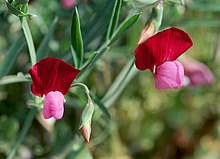Lathyrus clymenum
This article may need to be rewritten to comply with Wikipedia's quality standards. (April 2018) |
| Lathyrus clymenum | |
|---|---|

| |
| Scientific classification | |
| Kingdom: | Plantae |
| Clade: | Tracheophytes |
| Clade: | Angiosperms |
| Clade: | Eudicots |
| Clade: | Rosids |
| Order: | Fabales |
| Family: | Fabaceae |
| Subfamily: | Faboideae |
| Genus: | Lathyrus |
| Species: | L. clymenum
|
| Binomial name | |
| Lathyrus clymenum | |
| Synonyms[1] | |
| |

Lathyrus clymenum, also called Spanish vetchling,[2] is a flowering plant in the family Fabaceae, native to the Mediterranean. The seeds are used to prepare a Greek dish called fava santorinis. The plant is cultivated on the island of Santorini in Greece and was recently added to the European Union's products with a Protected Designation of Origin.
For 3,500 years residents of Santorini and neighbouring islands have been cultivating the legume species Lathyrus clymenum, known elsewhere only as a wild plant.[3] The peculiar ecosystem that was created by the volcanic explosions on Santorini island, the volcanic ash, the cellular soil, and the combination of humidity created by the sea and the drought, make the bean a unique resource. When weather conditions are good, farmers on the island can reap about 800 kilograms of beans per hectare. A vulnerable crop, it can be destroyed by strong winds that blow away its flowers before they can yield the pea, by drought or by a sudden heat wave almost instantly. Its production is thus limited, making it an expensive crop that costs €700 per acre. The cost for consumers is about €9–10 per kilogram.[citation needed]
Fava santorinis
[edit]The cooked fava are mixed with chopped onion into a purée, typically served with chopped onion, olive oil and lemon juice.
Nutrient content
[edit]The plant Lathyrus clymenum which the 'Fava Santorinis' is made of, has very high content of protein (25%) and is an excellent source of dietary fibre (26%). It is very low in fat, as most of its carbohydrates derive from complex carbohydrates and protein.
Although it looks like the Indian 'Toor Dal' or 'Chana Dal', it is a completely different species with much higher nutritional value.
There is historical evidence that pulses and in particular wild lentils started being cultivated in Greece in 6,000 BC (for example, Lathyrus clymenum was found in jars in the ruins of Akrotiri, Santorini, which date from approximately 1600 BC).[4] The Greek microclimate has been ideal for the evolution of such crops, and the Greeks have mastered their cooking and have benefited from their high nutritional value throughout history.
References
[edit]- ^ "The Plant List: A Working List of All Plant Species". Retrieved 7 March 2015.
- ^ "Lathyrus clymenum". Germplasm Resources Information Network. Agricultural Research Service, United States Department of Agriculture. Retrieved 7 March 2015.
- ^ Anaya Sarpaki, Glynis Jones, "Ancient and Modern Cultivation of Lathyrus clymenum L. in the Greek Islands" in Annual of the British School at Athens vol. 85 (1990) pp. 363–368 JSTOR
- ^ Panagiotakopulu, Eva; Higham, Thomas; Sarpaki, Anaya; Buckland, Paul; Doumas, Christos (2013-06-22). "Ancient pests: the season of the Santorini Minoan volcanic eruption and a date from insect chitin". Naturwissenschaften. 100 (7): 683–689. Bibcode:2013NW....100..683P. doi:10.1007/s00114-013-1068-8. ISSN 0028-1042. PMID 23793358. S2CID 17511722.
- Georgiopoulou, Tania. "Demand for Santorini fava outstrips supply". www.ekathimerini.com. Archived from the original on 2011-12-02. Retrieved 2013-01-06.
- "Συνταγή για Φάβα". www.santoriniinfo.gr.
- "Fava Santorinis". kopiaste.org.
External links
[edit]![]() Media related to Lathyrus clymenum at Wikimedia Commons
Media related to Lathyrus clymenum at Wikimedia Commons
